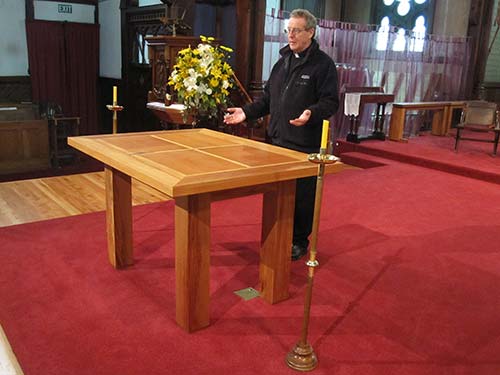
Part One
Recently, I visited new and also renewed parish church buildings and other new dedicated Christian worship spaces. I notice that many church buildings have continued the Medieval-shape altar – this shape was appropriate when the altar was against the East Wall of the church building. The priest would preside ad orientem (facing East) – “with his back to the congregation”.
These altars were wide – long from North to South. They obviously would have looked silly if they were less impressive from North to South.
Around the time of Vatican II, people simply moved this Medieval-style, sideboard-like altar a little bit out from the East wall (towards the top of the highest sanctuary step) and the priest now stood behind it. He looked like a barman standing behind his bar, but the renewal of Vatican II and the Liturgical Movement had at least made a first step.
It needed new post-Vatican II church buildings to be built in line with the vision of Vatican II before the side-board-like altars began to be be a thing of the past. Pre-Vatican II church buildings were also sensitively renewed to have altars of a more appropriate shape and brought into the body of the congregation in order to express the vision of Vatican II.
Part Two
Our language also needed to change to embody the vision of Vatican II. I still hear people talking about priests having their “back to the people”, “facing the congregation”, “westward facing”, and “turning the altar around”. But the vision of Vatican II is that all those present are included in the “full, conscious and active participation” (Section 14 Sacrosanctum Concilium) at the Eucharist. All present are gathered around God’s one table. And the shape of the altar table expresses this sense.
So it is disconcerting when we continue to see new altars that are still in the Medieval sideboard shape, over two-and-a-half metres wide (from North to South), and quite shallow in their depth. The priest continues to be barman-like, even though the sideboard-like bar may be closer to the patrons.
In reaction to the versus populum (towards the people) ad orientem (towards the east) fissure, I coined in circuitu altaris (around the altar) and in circuitu mensae (around the table). The Roman Eucharistic Prayer speaks of omnium circumstantium – “all of us who stand around this altar”. Architecturally, the altar table needs to speak of all standing around it.
There is another brand new church building opening soon. I will be very interested to see if it has the Medieval sense of congregants watching a bartender up the front, or if it becomes a good example of a post-Vatican II worship space encouraging and enabling a community to gather in circuitu mensae around an altar that is more square-like than Medieval sideboard-like, and all enabled to “full, conscious and active participation”.

Three months ago, I wrote about how architecture shapes us. There, I also pointed to the following:
A good starting point for reflection is my book, Celebrating Eucharist.
After that, do spend time with some of the following posts:
- The community – church architecture 1
- The cross – church architecture 2
- The altar – church architecture 3
- The font – church architecture 4
- The ambo/lectern – church architecture 5
- The presider’s chair and the cathedra – church architecture 6
- Church facing East – Architectural Design Guidelines 1
- Why churches face East – Architectural Design Guidelines 2
- The altar in architectural design – Architectural Design Guidelines 3
- The baptism font in architectural design – Architectural Design Guidelines 4
image: squarish altar in the crossing at St Michael and All Angels, Christchurch, New Zealand.
.


